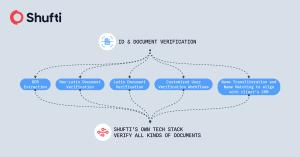Shufti Insight Highlights Growing Industry Shift Toward In-House Identity Verification Technology
The insight shows why choosing a vendor with a fully in-house tech stack is vital for secure, accurate, and scalable identity verification in digital markets.
LONDON, UNITED KINGDOM, November 26, 2025 /EINPresswire.com/ -- Shufti, the global identity verification provider, has published a new insight, “How to Turn Compliance into Growth with an IDV Partner that Owns Its Tech Stack,” outlining why choosing an IDV vendor with full technology-stack ownership is becoming a defining requirement for digital-first businesses.
As global e-commerce is projected to surpass $6.4 trillion by 2025, and more transactions shift into social and peer-to-peer environments, organisations are reassessing how verification systems protect users, support compliance, and sustain growth.
A central theme of the analysis is the distinction between verification providers that own their technology stack end to end and those that assemble it from third-party components. The former offer greater transparency, consistency, and control, while the latter introduces operational uncertainty and data-handling risks.
According to the insight, identity verification is no longer an isolated compliance step. The shift of onboarding, authentication, and account recovery into fully online workflows has widened the trust gap between businesses and users.
One of the key findings highlights the privacy implications of fragmented verification architectures. Providers that rely on external engines pass user data through multiple systems, creating what the report describes as a “chain of vulnerability.”
This concern is underscored by a 2025 incident in Italy, where customer data was compromised not through a provider’s own system but through vulnerabilities in its third-party vendor chain, reinforcing why businesses must choose IDV partners with full-stack ownership to ensure security, reliability, and long-term growth.
The analysis also emphasises the importance of customised verification logic. Markets now require verification flows aligned with jurisdiction-specific regulations, industry-level risk exposures, and sector-specific user behaviour.
Vendors owning their technology stack can modify logic, UI, risk thresholds, and fallback paths without relying on external release cycles, an increasingly important capability for digital platforms onboarding multilingual and cross-border users.
“Digital trust is determined by what a verification provider builds, not what it assembles. Organisations operating at scale need systems that can adjust immediately when fraud patterns shift or when regulators introduce new requirements. That adaptability is only possible when the technology stack is fully controlled by the provider, ensuring transparency, privacy and confidence at scale,” said Shahid Hanif, CEO of Shufti.
Handling edge cases is identified as another structural differentiator. The insight outlines that ID formats from smaller jurisdictions, older passports and licences, and paper-based documents still in circulation often fall outside international standards such as ICAO 9303.
Documents in Arabic, Cyrillic, Chinese and mixed-script formats further complicate verification for generic OCR models. Off-the-shelf engines often struggle with these formats, increasing error rates and manual review demands. In contrast, continuously trained in-house OCR and verification engines can adapt to complex typologies and reduce review overhead.
The insight further notes that rising fraud typologies, deepfakes, morphing, and replay attacks require verification systems capable of continuous recalibration. Vendors dependent on external engines often face delays that increase exposure. Proprietary systems, supported by dedicated R&D teams, can update decisioning models in real time and help organisations maintain low false-acceptance thresholds.
Shahid Hanif, CEO of Shufti, further adds;
“As businesses expand into new jurisdictions and onboard diverse user groups, they confront edge-case documents, mixed scripts and irregular formats that third-party engines struggle to interpret. Meeting these realities requires verification models that can react instantly and with precision. This level of accuracy is achievable only when OCR, fraud controls and risk logic are engineered and improved in-house, rather than assembled from external components.”
Operational cost reduction is another recurring theme. False alerts remain a significant burden for digital businesses, and the insight highlights that continuous tuning of in-house models combined with human review of anomalies can materially reduce review volumes and associated expenditure.
The insight also explains that Shufti’s proprietary technology, supported by its R&D teams, enables verification flows to be adapted in real time to regulatory and market-specific requirements. Shufti reports that its models are trained on complex and emerging fraud patterns, helping maintain a false-acceptance rate below 1% and reducing the cost of reviewing false alerts.
The report also notes that verifications are typically completed in about 30 seconds, with fallback intelligence supporting users facing issues such as low-quality images or limited connectivity.
Shufti adds that its fully in-house stack supports customised flows for sectors such as social media, crypto and fintech, with global script handling and accurate transliteration ensuring consistent onboarding across jurisdictions.
The analysis concludes that reliance on third-party verification components introduces a “chain of vulnerability.” In contrast, technology-stack ownership provides clear auditability, consistent performance, and the ability to maintain both compliance and user experience across global markets.
To read the full insight, visit:
https://shuftipro.com/insights/idv-vendor-that-builds-not-bundles/
About Shufti
Shufti is a global identity verification provider delivering document verification, facial biometrics, and risk-based authentication across financial services, fintech, crypto, e-commerce, online marketplaces, and regulated digital platforms. Operating across 240+ countries and territories, Shufti’s in-house technology stack supports multilingual scripts, complex document formats, and jurisdiction-specific verification requirements.
The company works with organisations seeking to strengthen compliance, improve operational efficiency, and reduce exposure to emerging fraud typologies. Shufti provides verification infrastructure that adapts to regulatory change, evolving fraud patterns, and industry-specific workflows, enabling secure onboarding and lifecycle management across international markets.
SOURCE SHUFTI
Neliswa Mncube
Shufti
+44 1225 290329
email us here
Visit us on social media:
LinkedIn
Bluesky
Instagram
Facebook
YouTube
TikTok
X
Shufti Open Demo Day | Age Verification
Legal Disclaimer:
EIN Presswire provides this news content "as is" without warranty of any kind. We do not accept any responsibility or liability for the accuracy, content, images, videos, licenses, completeness, legality, or reliability of the information contained in this article. If you have any complaints or copyright issues related to this article, kindly contact the author above.



